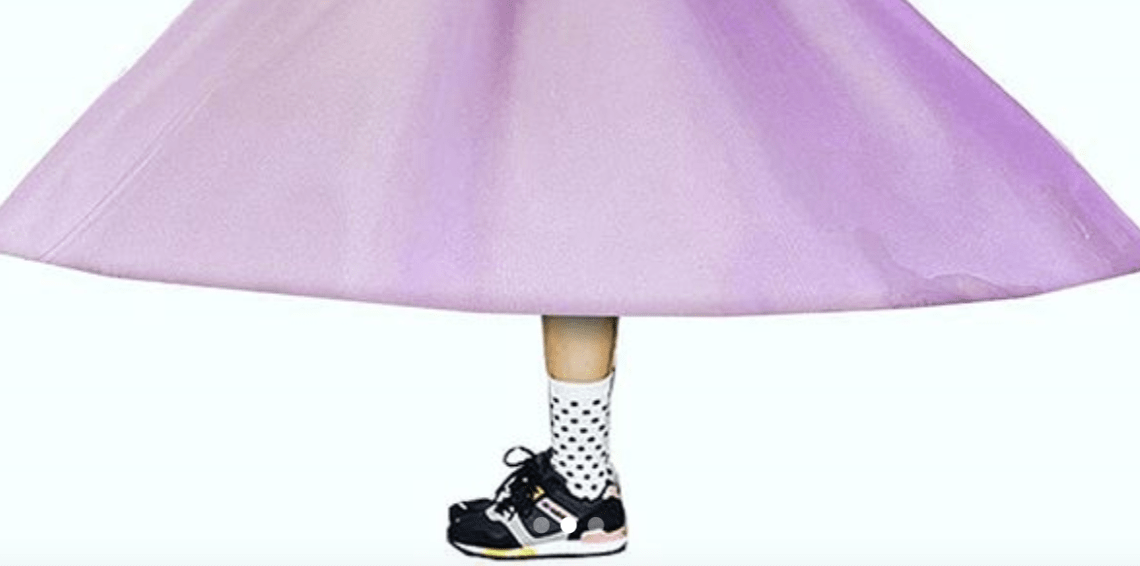Several months in, brands are coming to terms with the coronavirus as a permanent feature of the cultural landscape for at least the foreseeable future. The impact it’s had on fashion has been immense and immediate. And now, the effects are seeping into the design process, as well.
Dutch couture brand Viktor & Rolf debuted its fall 2020 collection, titled “Change,” earlier this week. It included a series of three dresses with large-circumference skirts, and one was covered in protuberances to mimic the look of the virus. According to the designers, as expressed in their campaign video released on July 15, the pieces were inspired by the pandemic and the importance of social distancing. The dresses are not yet for sale, but Viktor & Rolf pieces typically sell for more than $1,000.
Social distancing apparel, particularly of the kind involving large appendages extending outward, has become increasingly common. Brands like Puppets and Puppets and Area, both of which sell dresses in the $1,500 range, have begun introducing skirts with oversized hips and hoops, all playing on the idea of social distancing.
Veronica Toppino, a milliner and costume designer whose work is not typically sold commercially, has introduced several new hats with exceedingly wide brims, some of which are made of metal, to promote distancing. Meanwhile, Maison Margiela introduced a unique approach to face coverings in the form of a full face net (not likely an effective replacement for a genuine face mask).
Ad position: web_incontent_pos1
Even outside of traditional fashion brands, the idea of clothes as a way to protect oneself from the virus is catching on. The 59 Rivoli art gallery in Paris has begun handing out papier-mâché hats modeled off ones worn in the courts of China during the Song dynasty. They come equipped with broad wings as a way of encouraging people to stay three feet away from fellow gallery-goers.
Most of the pieces mentioned in this story are just now being rolled out on the (virtual) runway and in lookbooks; their prices have not been made public. (The brands mentioned declined or did not respond to request for comment.) While entertaining, these efforts aren’t likely meant to be money makers on their own. The real value is in the publicity they bring in.
“These types of products are helpful in getting new visitors to your site, which could indirectly influence sales as consumers then click around the site to potentially browse other items,” said Caroline Kim, lead apparel industry analyst at SimilarWeb. “Also, as Covid-19 remains top-of-mind, it’s a great way for brands to stay relevant and to ‘play their part’ in the fight against the virus, boosting brand perception. There is also the added bonus of possibly winning some search traffic for high-volume Covid-related keywords.”
Kim said that after Multiply, introduced a social-distancing-inspired petticoat in May, traffic to the brand’s website jumped 300% month-over-month.
View this post on Instagram
Ad rendering preventing in staging
Ad position: web_incontent_pos2
According to Krista Corrigan, retail analyst at Edited, this hints at what a socially-distanced future of fashion looks like. While the daring runway brands and conceptual artists like Toppino are experimenting with new designs now, the real shift will be more visible down the line, when those trends begin to trickle down to mass brands.
“More realistic offerings have been face masks with graphics, ironic slogans on T-shirts and the inclusion of PPE into garments,” she said. “A skirt with a six-foot hoop will certainly grab the attention of the consumer, but likely won’t translate to a high number of transactions.”




